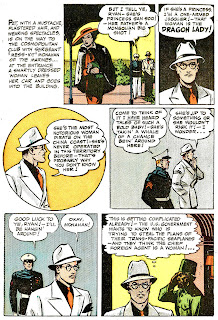Craig Yoe has an interesting Facebook page devoted to horror comics. Although I love them, I don’t show a lot of horror comics. Steve “Karswell” Banes in his Horrors Of It All blog does such an excellent job that I try to think of another angle when I do show horror.
So here it is. Three horror stories, slightly different than you might expect. First up, “Weird Tales” from Quality’s Hit Comics #1, which some claim is actually the first comic book horror story, done in 1940. I’m not sure of that, but I’m not ruling it out, either. Something that seems horrible to me is that the artist couldn’t keep the Old Witch’s look consistent on the first page. It also distinguishes itself by the most tepid horrors I’ve ever seen when the hotel “guest” peers through the keyhole at the phantasms haunting the inn. It’s historic, though, if we believe it’s really the first of its genre, so I’m including it.
Superior Comics of Canada published some great horror comics, but the printing was often terrible. The contents of the books were supplied by the Jerry Iger comic shop, and judging by the original artwork for “Here’s to Horror!” from Journey Into Fear #18 (1954), the artists who worked the story did a good job despite knowing how it would look once it came off the presses. A dialog paste-over on page has fallen off, so I’m including the panel from the printed comic where you can see it covered up the girl walking her dog. The artist(s) need not have gone to the trouble to provide an interesting background. Oh, and lead character, the crooner, Lanny, has a condition called spasmodic dysphonia, called “spastic throat” by the doctor in the story.
The scans came from the Heritage Auctions website. Thank you, HA!
\
Finally, I found this horror story of the living dead in an unlikely place, a comic book about Native Americans called Redskin #9 (1952). (That word is now considered a racial pejorative; my apologies to those offended.) When horror comics got popular then horrors started showing up in comics of other genres. The cover of this issue, though, has no indication that upon reading the book zombies will be encountered. The artwork is by Edwin Goldfarb and Bob Baer, a team who drew reams of crime and horror comics during this period.
More about →
So here it is. Three horror stories, slightly different than you might expect. First up, “Weird Tales” from Quality’s Hit Comics #1, which some claim is actually the first comic book horror story, done in 1940. I’m not sure of that, but I’m not ruling it out, either. Something that seems horrible to me is that the artist couldn’t keep the Old Witch’s look consistent on the first page. It also distinguishes itself by the most tepid horrors I’ve ever seen when the hotel “guest” peers through the keyhole at the phantasms haunting the inn. It’s historic, though, if we believe it’s really the first of its genre, so I’m including it.
Superior Comics of Canada published some great horror comics, but the printing was often terrible. The contents of the books were supplied by the Jerry Iger comic shop, and judging by the original artwork for “Here’s to Horror!” from Journey Into Fear #18 (1954), the artists who worked the story did a good job despite knowing how it would look once it came off the presses. A dialog paste-over on page has fallen off, so I’m including the panel from the printed comic where you can see it covered up the girl walking her dog. The artist(s) need not have gone to the trouble to provide an interesting background. Oh, and lead character, the crooner, Lanny, has a condition called spasmodic dysphonia, called “spastic throat” by the doctor in the story.
The scans came from the Heritage Auctions website. Thank you, HA!
\
Finally, I found this horror story of the living dead in an unlikely place, a comic book about Native Americans called Redskin #9 (1952). (That word is now considered a racial pejorative; my apologies to those offended.) When horror comics got popular then horrors started showing up in comics of other genres. The cover of this issue, though, has no indication that upon reading the book zombies will be encountered. The artwork is by Edwin Goldfarb and Bob Baer, a team who drew reams of crime and horror comics during this period.

























































































